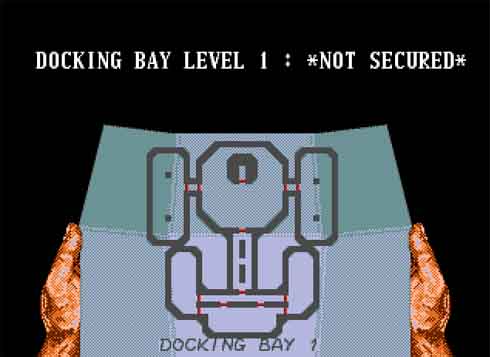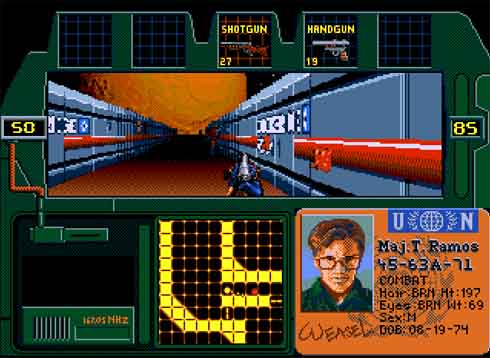
It’s happened to all of us at some point, I’m sure – at least, to those of us who have been gaming for a significant amount of time. We buy the latest and greatest game containing some new features that have everyone foaming at the mouth, only to sit back and say, “Hey, that’s not so original, I remember doing this in X-game back on X-platform in 199X!â€
If this has ever happened to you, then this article is for you. This feature will run in as many parts as we can find games to fill it, each time looking at a title from any possible platform that gave us a glimpse of things to come, ideas that wouldn’t be seen again for years until other developers cottoned on to what a good idea it actually was. If you have any ideas for games you would like to see mentioned here, then shoot us a mail with the name of the game and a brief but clear explanation of why you think it was ahead of its time.
So, without any further ado, let’s begin the very first LazyGamer: Ahead of its Time feature.
Title: Zero Tolerance
Platform: MegaDrive
Developer: Technopop
Publisher: Accolade
Year: 1994
Genre: First Person Shooter
Back in the early to mid 90’s, developers released a near-endless torrent of First Person Shooters, mostly for the PC, following the worldwide FPS craze started by Doom. At this point, the humble little MegaDrive didn’t seem to be the best console to own if you fancied sliding down corridors, blasting the shinola out of highly-pixelated enemies in (fake) 3D space. The MegaDrive was created to display and manipulate 2D sprites after all, not compute complicated mathematical algorithms to generate 3D viewpoints.
However, that didn’t stop a small development studio called Technopop from trying their hand at creating a First Person Shooter specifically for the rapidly-aging 16-bit console. Zero Tolerance was the fruit of their labours, and it shattered a great many expectations when it was released. Not only was it a FPS on the MegaDrive, but it contained features that wouldn’t be seen in FPS games on the PC for at least the next two years – and it allowed two players to link up their MegaDrives to play cooperatively or head-to-head like PC gamers had been doing for so long – something that wouldn’t be seen again for consoles until mid-way through the PlayStation 1’s life. If that’s not enough for you, the developers also claim that it was the very first FPS game for a home console EVER. This would put it a few months ahead of Imagineer’s port of iD Software’s Wolfenstein 3D for the SNES, and a year ahead of Sculptured Software’s port of iD’s Doom for the SNES. That’s already a grab-bag full of kudos right there, but we haven’t even gotten started yet.

In order to beat out the competition in the early 90’s FPS “arms raceâ€, developers constantly tried to offer more features and “real world†capabilities in their game engines. This was still two years before the first true 3D engine appeared in the form of iD Software’s Quake; a time when most FPS games still used a method of faking 3D environments by drawing 2D images that looked 3D, a-la Wolfenstein 3D and Doom. There was only so much that could be done with this technique and every developer tried to push it in different ways. Raven Software used iD’s Doom engine to create their fantasy FPS, Heretic, but added in the capabilities to carry an inventory of items, fly, and look up and down to some extent. Capstone Software’s offering, Witchaven, attempted to use photographed textures for the environments and photographed, stop-motion miniatures for sprites to increase the realism; and while the game looked pretty good, the gameplay was heavy on the suck factor.

Zero Tolerance managed to keep its head above the water by concentrating largely on the gameplay, which was great, before giving us over-the-top on the graphical effects. Zero Tolerance used the same kind of fake 3D engine that all PC FPS games used at the time, but added in some highly competitive capabilities. For starters, you could choose from a roster of five characters, each with their own specialization, and each of whom could walk, strafe, jump, duck and even perform an array of martial arts techniques when bare-handed. Hell, you could even perform a flying kick by running, jumping, and then entering the kick command in mid-air! This degree of movement and control in a FPS game was rare or possibly even unheard of at the time.
Like Raven’s Heretic, your character could hold an inventory of items, including weapons, armour, useful gadgets, and the occasional tool needed to pass an area. Zero Tolerance was also one of the first FPS games to feature hand-grenades as a weapon, and even allowed players to bounce these grenades off walls to blow up unsuspecting enemies in the next room! The ability to bounce grenades around corners wouldn’t be effectively employed again until the advent of Quake with its grenade launcher weapon. Zero Tolerance was also the first console FPS to offer multiplayer. Unfortunately, there was no split-screen mode, only the system-link option, and you had to fill in a form to receive the link-cable for free if you wanted to do this. I filled in the form myself, and even though South Africa was not listed as one of the eligible countries for the offer, they still sent me the cable – for free! I kid you not, I still have it. Once you had two MegaDrives, two TVs and two copies of Zero Tolerance in the same room with the link cable, MegaDrive owners could experience playing multiplayer FPS games in the same way that was popular with PC gamers using null-modem cables to play two-player sessions of their favourite FPS games.

But that’s not all. Zero Tolerance also featured a number of interesting graphical effects that wouldn’t be seen again for some time. Easily the most of impressive of these effects was the blood. Sure, Doom may have had crisper graphics, and Doom’s guns did produce little red blood splats when you shot the monsters, but in Zero Tolerance, the blood would actually fly out of your enemies and splat on the floor, ceiling, or walls, dripping down until it formed a puddle on the floor. I’m dead serious, it was in there. This is something that wasn’t seen again for years to come, possibly only with the advent of the Quake 2 engine. Zero Tolerance also featured destructible scenery and textures, something that would only be surpassed by Duke Nukem 3D two years later. One of the coolest effects in the game, though, was on the top level of the high-rise, where a board room featured a TV with an animated texture on it of a news-reporter reporting on the events your character was participating in, showing the smoking, burning building and even footage of the chopper which had dropped your character off.
Interestingly enough, if you have any doubts about the validity of my comments about this game, then feel free to go and download it and play it for yourself. That’s right, you can actually download the Zero Tolerance ROM legally from Technopop’s website! They’ve made it free to the public, along with what little they managed to make of the sequel, Beyond Zero Tolerance, before the project was cancelled. They also have the wiring procedure to create a link cable for the Megadrive yourself – I guess for those players who still own the actual cartridge and a Megadrive and would like to play it in multiplayer. Check it all out at: http://www.technopop.net
Taking all of these graphical touches, gameplay innovations, and the ability to play system-link multiplayer into account, it’s easy to see why Zero Tolerance shattered the limited expectations people had of the MegaDrive to produce a First Person Shooter which could compete with those on the PC. All this coupled with the fact that some of its features would not be offered in PC or console FPS games for years afterwards truly make Zero Tolerance a game that was ahead of its time.
Last Updated: March 18, 2009






















Goose ZA
March 18, 2009 at 12:52
Great article =)
Geoff
March 18, 2009 at 13:04
Cool article! Unfortunately Technopop are mistakenly blowing their own horns. the first FPS for Megadrive/Genesis was a game by the name of “Corporation” or “Cyber-cop”. It was a port of an Atart ST game, originall released in 1990.
The Megadrive port actually preceded the PC release of Wolfenstein 3D. Also notable was the ability in-game to enhance parts of your body, much like the later System Shock and Deus Ex games.
Actually, thinking about it – corporation was very ahead of its time! :biggrin:
Q121
March 18, 2009 at 13:50
Nice article 🙂
I am enjoying these walks down memory lane 🙂
SlippyMadFrog
March 18, 2009 at 15:42
Nice article.
In the defence of doom and wolfenstein, the stage itself like the walls and floors was true 3D, only the entities like bad guys and items in the stage itself where fake 3D.
I actualy downloaded and played Doom 1 the other day with dosbox, good times.
Matthew
March 18, 2009 at 18:18
You’re right about the who Corporation thing. That was the first First Person game on the MegaDrive, for sure. Perhaps the developers and Technopop meant to say that it was the first First Person “Shooter”. Corporation was sort of a mix of something else, and it didn’t work all that, let’s be honest. I guess that’s the problem with being ahead of your time, you don’t know the best approach to take when you’re on the cutting edge.
I remember System Shock. The controls were a little finicky, but it was a great game overall. Got an 18+ slapped on its head because of your character could use drugs in the game.
Matthew
March 18, 2009 at 18:23
Actually, no, the stages in Doom and Wolf3d were not true 3D. You were completely unable to look up and down in Wolfenstein 3D, and in the Doom engine, the games that let you look up and down, like Heretic, caused something called “polar distortion”, which was a side effect of trying to simulate 3D graphics in a 2D engine. It also happened in Duke Nukem 3D, even though 3D Realms’ “Build” engine was much more advanced.
They looked like true 3D engines, but they weren’t.
Matthew
March 18, 2009 at 18:23
Thanks.
SlippyMadFrog
March 18, 2009 at 19:06
Cool, you obviously know more than me on the subject 🙂
I noticed that the entities all look the same when you looked at them from different angles, it was just sprites, so I thought that was the fake part. I stand corrected.
Matthew
March 18, 2009 at 21:45
Well, it doesn’t really matter. It’s all tech talk anyway. Before the term First Person Shooter came into use, they used to be called “3D games”, and that’s because, to all intents and purposes, they looked 3D.
I guess when true 3D games started appearing, and suddenly racing games, platform games, and even sports games could suddenly fall under the “3D label”, they suddenly needed some more specific definitions.
But yeah, those flat sprites they used for enemies and other icons did actually look even more 2D than the rest of the games, so I know what you’re referring to there.
SlippyMadFrog
March 19, 2009 at 08:34
I remembered when the first time I played Quake, after I killed a guy I strafed around and went “Wow! they looked different from all angles!”. Good times
Lupus
November 3, 2009 at 12:35
I’ve honestly played way to many games, but Wasteland sticks up in my mind for using the stats similar to SPECIAL way back in 1985. Also Dune 2 for bringing RTS to the mainstream yes there was a game previously that was an RTS but Dune 2 is the true Grand daddy, it actually spawned more.
One game not repeated which was pretty cool and interesting was Homeworld.